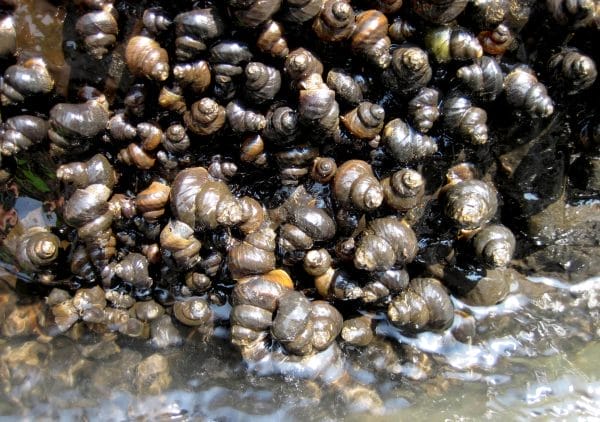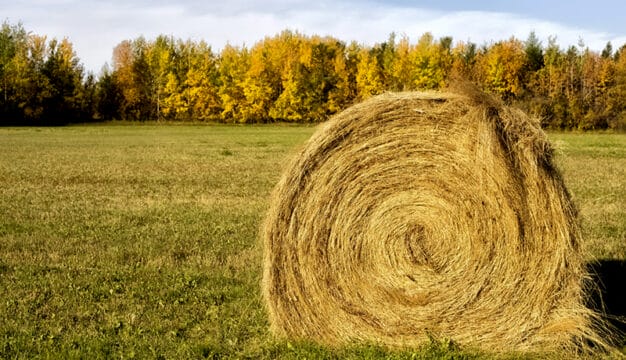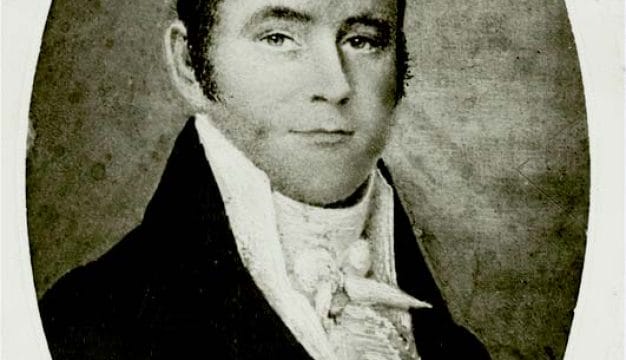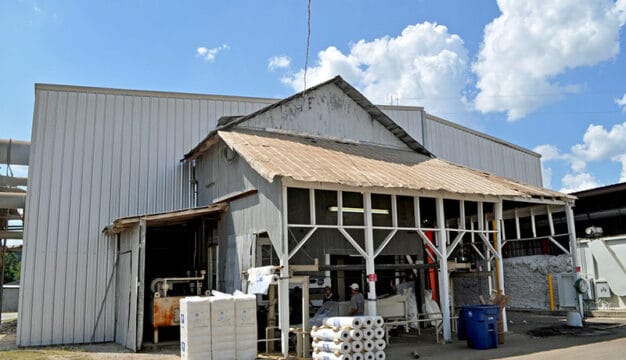Tulotoma Snail
 Tulotoma Snail
Tulotoma magnifica is a live-bearing freshwater snail that was first discovered in Alabama in 1834. It was once found in huge numbers in the Alabama River and its tributaries from Calhoun County south to Monroe County. Its populations declined dramatically in the early to mid-twentieth century as a result of habitat destruction. Recovery efforts implemented by the U.S. Fish and Wildlife Service enabled its survival, and the species was downgraded from endangered to threatened in 2010. In 2023, the Freshwater Land Trust acquired 1,128 acres of land in Coosa County for conservation that will further ensure the snail’s survival.
Tulotoma Snail
Tulotoma magnifica is a live-bearing freshwater snail that was first discovered in Alabama in 1834. It was once found in huge numbers in the Alabama River and its tributaries from Calhoun County south to Monroe County. Its populations declined dramatically in the early to mid-twentieth century as a result of habitat destruction. Recovery efforts implemented by the U.S. Fish and Wildlife Service enabled its survival, and the species was downgraded from endangered to threatened in 2010. In 2023, the Freshwater Land Trust acquired 1,128 acres of land in Coosa County for conservation that will further ensure the snail’s survival.
The Alabama live-bearing snail, Tulotoma magnifica, was described in 1834 by Philadelphia naturalist Timothy A. Conrad from specimens he collected in the Alabama River near Claiborne, Monroe County. He noted that the snails appeared “in vast abundance,” with 20 or 30 individual snails attached to the undersides of flat rocks in the river’s shoals and riffles.
Conrad bestowed the name “magnifica” for good reason, because the snail’s globular, golfball-sized shells are magnificently ornamented with spirals of protuberant knobs. Its reproductive habits were also of great interest to him because the species gives birth to live, fully formed young rather than larvae or eggs. These juveniles remain protected within their mothers until they reach two to four millimeters long and then are released into the water from early spring to early autumn. After attaching themselves to the underside of a rock, they feed on algae, bacteria, and floating detritus. They most likely live three to five years.
The tulotoma was later found in large numbers (sometimes several hundred individuals under a single boulder) in tributaries of the Alabama River, especially the Coosa River system. But within 100 years, the snail population was in steep decline. It had disappeared completely from the Alabama River, including its original discovery site at Claiborne. By the 1950s, only a handful of living individuals existed in Big Canoe Creek, Choccolocco Creek, and Kelley Creek. In 1976, Tulotoma magnifica was declared likely extinct.
Many factors contributed to the tulotoma’s demise. The most significant, however, was the impoundment of the Coosa and Alabama rivers for hydropower and navigation. Between 1914 and 1966, six major dams were built on the Coosa that drowned out the shoal areas required by the snail. Similar projects affected the Alabama River. Over the years, these river systems—which once held the most diverse freshwater fauna in the world—suffered catastrophic losses, especially to their snail and mollusk populations.
 Tulotoma Snail Cluster
In 1988-89, an extensive survey for the tulotoma was conducted throughout its historic range. Field biologists rediscovered the snail in the main stem of the Coosa River below Jordan Dam, as well as in four Coosa River tributaries: Ohatchee, Kelley, Weogufka, and Hatchet creeks. The tulotoma was subsequently listed in 1991 by the U.S. Fish and Wildlife Service as an endangered species. As part of a plan to help this species, federal scientists advised the Alabama Power Company to modify the water release schedules from its hydroelectric dams for the impounded river sections. The revised releases have since been better timed to coincide with the tulotoma’s reproductive cycle and to improve its habitat, especially by raising the water’s dissolved oxygen level. These efforts produced a dramatic rise in the tulotoma population and expansion of the species’ range. In 2010, the U.S. Fish & Wildlife Service improved the snail’s status from endangered to threatened, representing a success story for the Endangered Species Act of 1973 and the combined efforts of the federal, state, public, and private entities that accomplished its recovery.
Tulotoma Snail Cluster
In 1988-89, an extensive survey for the tulotoma was conducted throughout its historic range. Field biologists rediscovered the snail in the main stem of the Coosa River below Jordan Dam, as well as in four Coosa River tributaries: Ohatchee, Kelley, Weogufka, and Hatchet creeks. The tulotoma was subsequently listed in 1991 by the U.S. Fish and Wildlife Service as an endangered species. As part of a plan to help this species, federal scientists advised the Alabama Power Company to modify the water release schedules from its hydroelectric dams for the impounded river sections. The revised releases have since been better timed to coincide with the tulotoma’s reproductive cycle and to improve its habitat, especially by raising the water’s dissolved oxygen level. These efforts produced a dramatic rise in the tulotoma population and expansion of the species’ range. In 2010, the U.S. Fish & Wildlife Service improved the snail’s status from endangered to threatened, representing a success story for the Endangered Species Act of 1973 and the combined efforts of the federal, state, public, and private entities that accomplished its recovery.
A
Further Reading
- Bogan, Arthur E., J. Malcolm Pierson, and Paul Hartfield. “Decline in the Freshwater Gastropod Fauna in the Mobile Bay Basin.” In Our Living Resources: A Report to the Nation on the Distribution, Abundance, and Health of U.S. Plants, Animals, and Ecosystems, edited by Edward T. LaRoe et al., pp. 249-52. Washington, D.C.: U.S. Department of the Interior, National Biological Service, 1995.
- Davenport, L. J. “Tulotoma, the Alabama Live-Bearing Snail.” Alabama Heritage 38 (Fall 1995): 48, 50.
- Hershler, Robert, J. Malcolm Pierson, and R. Stephen Krotzer. “Rediscovery of Tulotoma magnifica (Conrad) (Gastropoda: Viviparidae).” Proceedings of the Biological Society of Washington 103 (1990): 815-24.
- Stein, Carol B. “Gastropods.” In Endangered and Threatened Plants and Animals of Alabama, edited by Herbert Boschung, pp. 21-41. Tuscaloosa: Bulletin of the Alabama Museum of Natural History 2 (1976): 1-92.



